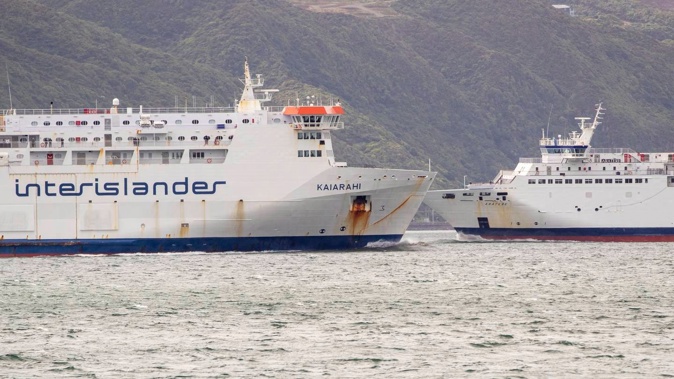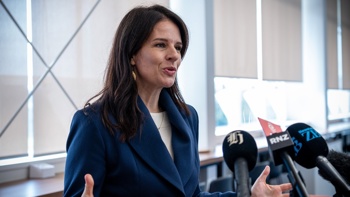
KiwiRail has dragged up an old stoush over the location of its Cook Strait mega ferry terminal in Wellington to explain why project costs ballooned to almost $3 billion.
The Government has declined KiwiRail’s request for an extra $1.47 billion, scuppering the Inter-island Resilience Connection (iReX) project.
As KiwiRail bosses fronted a select committee today, they issued a stark warning that new infrastructure will be needed, regardless of the fate of iRex, because the wharf at Port Marlborough is at “a very end-of-life state”.
Finding second-hand ferries to replace KiwiRail’s ageing Interislander fleet won’t be easy either. Shipbrokers estimate just 22 ships in the world would be suitable and none of them is for sale.
Finger pointing over location of Wellington terminal
KiwiRail chief executive Peter Reidy told the transport and infrastructure select committee there was significant time lost deciding on the location of the terminal in Wellington which contributed to cost escalations.
KiwiRail wanted a single-user terminal at King’s Wharf in downtown Wellington to accommodate the new mega ferries.
But other stakeholders, including the regional and city councils, CentrePort, NZTA and Bluebridge, preferred Kaiwharawhara.
There were concerns water sports would be put at risk with a terminal at King’s Wharf, and the size of a parking and traffic management area required to service it would decrease the amenity value of the area.
KiwiRail backed down at the end of 2020 and was left with only a few months to work on the Kaiwharawhara option before a detailed design business case was finalised in June 2021, Reidy said.
“It was a bit of a sprint.”
- 'KiwiRail must be s***ing themselves': Cook Strait ferry cost blowout lands with Nicola Willis
- Billion dollar blowout: Govt declines to fund Cook Strait mega-ferry project
- KiwiRail visited South Korean shipyard after Government scuppered ferries
“The amount of geotechnical work that had been done in Kaiwharawhara, which was quite different from King’s Wharf, was very immature.”
Reidy said natural hazard risk modelling has changed since then and the fallout from the likes of the Kaikōura earthquake is still being filtered into building standards.
The Kaiwharawhara site meant building on an earthquake plate that required 270 piles going 70 metres into the ground, he said.
The seismic risks alone accounted for a $250 million increase in costs.
There was also a flood risk that required the site to be raised by 1 metre, Reidy said.
Board chairman David MacLean stressed the project’s cost blowout was not driven by the size of the ships but rather a “perfect storm of factors” including the change of the terminal location, the seismic code, and inflation.
/cloudfront-ap-southeast-2.images.arcpublishing.com/nzme/WV667VL5TNCE3GFNYKR3CRSNTI.jpg)
KiwiRail board chairman David MacLean stressed the project’s cost blowout was not driven by the size of the ships but rather a “perfect storm of factors. Photo / Mark Mitchell
Chief capital planning and asset development officer David Gordon said they were keen on King’s Wharf because it was closer to the CBD and they knew Kaiwharawhara was a seismically active zone.
“GW [Greater Wellington, the regional council] and everybody else said: ‘No we don’t want you there’.
“They weren’t paying for it but there comes a point in time with any project, if every stakeholder is against what you want to do . . . at some point, you’ve got to give up the fight.”
Stark warning over state of port infrastructure
Reidy acknowledged the Government’s decision to move on from the mega ferries.
However, he issued a stark warning about the state of portside infrastructure on either side of Cook Strait.
“The terminals have to be built. New Zealand, that’s all of us, has to find a solution. Port Marlborough wharf has probably got about two to three years left. It is at a very end-of-life state. You talk to CentrePort, there’s work we’ve got to do as well.”
This infrastructure, enabling a safe and resilient Cook Strait crossing, was of national significance, McLean said.
“The question we have always struggled with is: Why was KiwiRail building terminals? We are not a wharf owner.
“We were sort of carrying most of the cost with the Government of that and running the project but that’s not necessarily the only answer.”
In the market for secondhand ships
Before Christmas, Reidy suggested part of the iRex plan could be salvaged and that the mega ferries could still be built and then sold instead.
But Finance Minister Nicola Willis said this was a risky strategy and Reidy announced yesterday that KiwiRail has officially started discussions to terminate the contract with Hyundai Mipo Dockyard (HMD) to build the ferries.
Reidy said they were now in the market for second-hand ships.
But they need to find ships built after 2010 which have redundancy built into their mechanical systems, Reidy said.
“If we don’t find ships that are of that level, we are just replacing our ships with other old ships with no redundancy.”
Having this redundancy would avoid situations like when Kaitaki lost power in Cook Strait last year and issued a mayday call because all four engines shut down when there was a problem with the one cooling system.
McLean said there was a shortage of second-hand ships and there was a huge queue for getting new ones built.
Indications from shipbrokers were that there were only 22 second-hand ships in the world that would meet KiwiRail’s criteria, including the capability to cross Cook Strait’s notorious waters, and none of them was for sale, McLean said.
However, that could change if KiwiRail had an active bid in the market, he said.
The $551m fixed-price contract to build the new ferries has proven to be a good price.
If the same contract were signed today, KiwiRail estimated the cost could increase by as much as 40 per cent.
KiwiRail had spent $424m on the iRex project as of the end of December. Of this, $90m was spent on the ships, $300m on the terminals, and the rest on programme management costs.
This does not include the cost of breaking the ship-building contract which is still being negotiated.
Georgina Campbell is a Wellington-based reporter who has a particular interest in local government, transport, and seismic issues. She joined the Herald in 2019 after working as a broadcast journalist.
Take your Radio, Podcasts and Music with you









